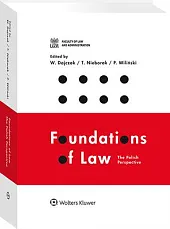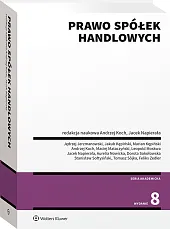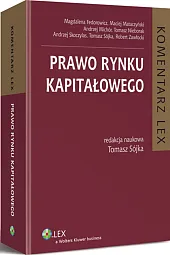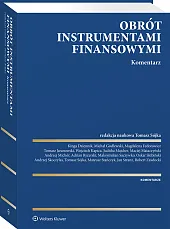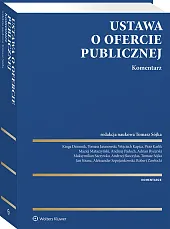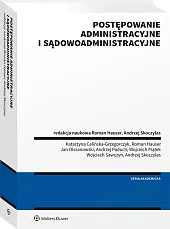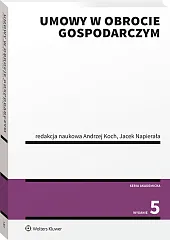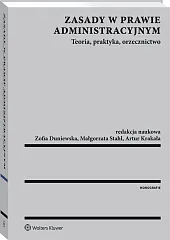“Foundations of Law: The Polish Perspective” covers a range of issues forming the core of academic legal education in Poland. It provides basic knowledge about Polish law and Polish legal...
Pełny opis“Foundations of Law: The Polish Perspective” covers a range of issues forming the core of academic legal education in Poland. It provides basic knowledge about Polish law and Polish legal culture, and constitutes an innovative introduction to the European approach to the concept of law, legal reasoning, recent challenges and the problems of legal development.
MniejFoundations of Law: The Polish Perspective
Foundations of Law: The Polish Perspective
Roman Budzinowski, Katarzyna Celińska-Grzegorczyk, Jagoda Dzida, Magdalena Fedorowicz, Tadeusz Gadkowski, Justyna Goździewicz-Biechońska, Agata Hauser, Jędrzej Jerzmanowski, Marian Kępiński, Jakub Kępiński, Katarzyna Kokocińska, Eryk Kosiński, Katarzyna Leśkiewicz, Piotr M. Pilarczyk, Dominik Mączyński, Maciej Mataczyński, Marta Nawrocka, Adam Olejniczak, Krystyna Paluszyńska-Daszkiewicz, Marlena Paszko, Sławomir Pawłowski, Wojciech Piątek, Justyn Piskorski, Bożena Popowska, Marcin Princ, Michał Skąpski, Andrzej Skoczylas, Marek Smolak, Tomasz Sójka, Tomasz Sokołowski, Łukasz Sokołowski, Hanna Suchocka, Aneta Suchoń, Marcin Walasik
“Foundations of Law: The Polish Perspective” covers a range of issues forming the core of academic legal education in Poland. It provides basic knowledge about Polish law and Polish legal...
Pełny opis“Foundations of Law: The Polish Perspective” covers a range of issues forming the core of academic legal education in Poland. It provides basic knowledge about Polish law and Polish legal culture, and constitutes an innovative introduction to the European approach to the concept of law, legal reasoning, recent challenges and the problems of legal development.
Mniej Opis publikacji
“Foundations of Law: The Polish Perspective” covers a range of issues forming the core of academic legal education in Poland. It provides basic knowledge about Polish law and Polish legal culture, and constitutes an innovative introduction to the European approach to the concept of law, legal reasoning, recent challenges and the problems of legal development.
![]() The book contains nineteen chapters, the aim of each being to give an understandable presentation and discussion of a specific area of law. The early chapters present an overview of the historical foundations of Polish law and the Polish theory and philosophy of law. The following chapters address private, public, criminal and economic law as is applied in Poland. Diagrams have been included to increase clarity of the text and some...
The book contains nineteen chapters, the aim of each being to give an understandable presentation and discussion of a specific area of law. The early chapters present an overview of the historical foundations of Polish law and the Polish theory and philosophy of law. The following chapters address private, public, criminal and economic law as is applied in Poland. Diagrams have been included to increase clarity of the text and some...
“Foundations of Law: The Polish Perspective” covers a range of issues forming the core of academic legal education in Poland. It provides basic knowledge about Polish law and Polish legal culture, and constitutes an innovative introduction to the European approach to the concept of law, legal reasoning, recent challenges and the problems of legal development.
![]() The book contains nineteen chapters, the aim of each being to give an understandable presentation and discussion of a specific area of law. The early chapters present an overview of the historical foundations of Polish law and the Polish theory and philosophy of law. The following chapters address private, public, criminal and economic law as is applied in Poland. Diagrams have been included to increase clarity of the text and some contributions are supplemented with case studies. Further reading in other languages recommended by the authors of individual chapters will facilitate a more in-depth understanding of Polish law and Polish legal culture as a part of the tradition of civil law, which is currently also a reflection of the legislative activity of the European Union.
The book contains nineteen chapters, the aim of each being to give an understandable presentation and discussion of a specific area of law. The early chapters present an overview of the historical foundations of Polish law and the Polish theory and philosophy of law. The following chapters address private, public, criminal and economic law as is applied in Poland. Diagrams have been included to increase clarity of the text and some contributions are supplemented with case studies. Further reading in other languages recommended by the authors of individual chapters will facilitate a more in-depth understanding of Polish law and Polish legal culture as a part of the tradition of civil law, which is currently also a reflection of the legislative activity of the European Union.
This publication is the joint work of members of the Faculty of Law and Administration, Adam Mickiewicz University, Poznań. The Faculty is one of the largest and best law schools in Poland and has been consistently rated as one of the best in the country. The Faculty was established in its original form in 1919, at the same time as the University itself. The Faculty meets the requirements of contemporary trends in higher education by conducting high level research. The academic staff recognize the demands of social processes and seek to create value for society, science, culture and the economy. Consequently, the results of the research conducted at the University at local, international and interdisciplinary level may be applied in practice.
Fragment dla Ciebie
Informacje
Spis treści
Abbreviations ......................................................................................................................23
Preface ..................................................................................................................................27
Historical foundations of Polish law (Wojciech Dajczak, Piotr M. Pilarczyk) .........31
1. History of Polish public law (Piotr M. Pilarczyk).....................................................32
1.1. Creation of the state. The First Polish Republic ...............................................32
1.1.1. Evolution of the system .............................................................................32
1.1.2. Pre-partition public law ............................................................................36
1.2. Partitions ................................................................................................................37
1.2.1. Forms
...
Abbreviations ......................................................................................................................23
Preface ..................................................................................................................................27
Historical foundations of Polish law (Wojciech Dajczak, Piotr M. Pilarczyk) .........31
1. History of Polish public law (Piotr M. Pilarczyk) .....................................................32
1.1. Creation of the state. The First Polish Republic ...............................................32
1.1.1. Evolution of the system .............................................................................32
1.1.2. Pre-partition public law ............................................................................36
1.2. Partitions ................................................................................................................37
1.2.1. Forms of Polish statehood ........................................................................37
1.2.2. Public law of the partitions .......................................................................39
1.3. The Second Polish Republic ............................................................................... 40
1.3.1. Political system of the state ...................................................................... 40
1.3.2. Public law ....................................................................................................41
1.4. World War II and post-War Poland .................................................................. 43
1.4.1. World War II .............................................................................................. 43
1.4.2. People’s Poland .......................................................................................... 43
1.4.3. Public law of the totalitarian state .......................................................... 45
1.4.4. Public law of the transition period ......................................................... 46
1.5. Conclusions ...........................................................................................................47
2. Historical development of private law in Poland (Wojciech Dajczak) ................. 48
2.1. Sources of private law in Polish territories ...................................................... 48
2.1.1. Law in the feudal period .......................................................................... 48
2.1.2. Idea of codification of private law in Poland before 1795 ....................49
2.1.3. ALR, Code civil, ABGB and BGB in Polish territories in the 19th and 20th centuries ...........................................49
2.1.4. Polish codification of private law in 1919–1939 .................................... 50
2.1.5. Unification of private law in 1945–1946 .................................................51
2.1.6. Development of the law in 1946–1989 ....................................................52
2.1.7. Changes in Polish private law in 1990–2020 .........................................53
2.2. Impact of ius commune and civil tradition on private law in Poland .................................................... 54
2.3. Fundamental question of civil law in the light of the development of Polish law ..................................... 56
2.3.1. General part of civil law ........................................................................... 56
2.3.2. List of rights in rem ....................................................................................57
2.3.3. Concept of ownership ................................................................................59
2.3.4. Sources of obligations .............................................................................. 60
2.3.5. Freedom of contract ..................................................................................61
2.3.6. Model of delictual liability .......................................................................62
2.3.7. Model of statutory succession .................................................................63
2.3.8. Limits of freedom of testation ................................................................ 64
2.4. History and style of Polish private law .............................................................65
References .......................................................................................................................... 66
Polish theory and philosophy of law: An overview of the origins, ideas and people (Marek Smolak) ........................71
1. Introduction ..................................................................................................................71
2. General characteristics of the basic trends and subject of research of contemporary Polish theory and philosophy of law ...........................................72
2.1. Subjects of research in the years 1918–1989 ......................................................73
2.2. Research problems and development trends in the Polish theory and philosophy of law in the years 1989–2020 .................................................78
3. Leading figures in the Polish theory of law ............................................................. 80
4. Key achievements of the Polish theory of law ......................................................... 86
4.1. Poznań School of Legal Theory ......................................................................... 86
4.2. Wróblewski’s theory of legal interpretation .....................................................92
4.3. Woleński and Opałek’s concept of a non-linguistic legal norm ....................95
5. Conclusion .................................................................................................................... 96
References ...........................................................................................................................97
Polish constitutional law (Agata Hauser, Hanna Suchocka) .....................................101
1. Constitutional development (evolution) – constitutional heritage in Poland (Hanna Suchocka) ................... 102
2. The essence of the constitution (Hanna Suchocka) ...............................................105
3. Constitutional principles (Hanna Suchocka) .........................................................106
3.1. The principle of constitutional supremacy and constitutional justice .......107
3.2. The principle of national sovereignty ..............................................................109
3.3. The principle of independence and sovereignty of the state ........................110
3.4. The principle of the democratic state ruled by law ........................................111
3.5. The principle of the separation of powers .......................................................113
3.6. The principle of the recognition of a civic society .........................................114
3.7. The principle of inherent human dignity .......................................................115
3.8. The principle of the social market economy ..................................................115
3.9. The principle of decentralization (local government) ..................................116
4. Freedoms, rights and obligations (Agata Hauser) .................................................116
4.1. General principles ...............................................................................................116
4.2. Limitations ...........................................................................................................118
4.3. Limitations at times of extraordinary measures ............................................118
4.4. Guarantees of freedoms and rights ..................................................................119
5. Sources of law (Agata Hauser) ..................................................................................121
5.1. Universally binding law and acts of an internal nature ................................121
5.2. Hierarchy of domestic legal acts .......................................................................121
5.3. International law ................................................................................................ 123
5.4. EU law .................................................................................................................. 124
6. Electoral law and direct democracy (Agata Hauser) ............................................ 125
7. Legislature (Agata Hauser) ...................................................................................... 126
7.1. Structure, term of office, status of deputies and senators ............................ 126
7.2. Legislative process ..............................................................................................129
7.3. Other functions of the parliament .................................................................. 130
8. The Executive (Agata Hauser) ..................................................................................131
8.1. The President of Poland .....................................................................................131
8.2. The Council of Ministers ...................................................................................133
9. The Judiciary (Agata Hauser) ...................................................................................135
9.1. General remarks ..................................................................................................135
9.2. Courts ...................................................................................................................136
9.3. The Constitutional Tribunal .............................................................................138
9.4. The Tribunal of State ..........................................................................................140
10. Current developments and the EU rule of law procedures (Agata Hauser, Hanna Suchocka) ...............141
References .........................................................................................................................143
Civil law (Jędrzej Jerzmanowski, Jakub Kępiński, Marian Kępiński, Adam Olejniczak, Tomasz Sokołowski) ...................147
Part 1. General provisions of the Civil Code (Marian Kępiński, updated by Jakub Kępiński) .................... 150
1. Introduction ............................................................................................................... 150
2. Structure of the Civil Code .......................................................................................152
3. Relationship of the Civil Code to other branches of private law ........................153
4. Subjects of civil law relations .................................................................................. 154
4.1. Natural persons ................................................................................................. 154
4.2. Limited capacity ................................................................................................ 154
4.3. Identification of natural persons .................................................................... 156
4.4. Protection of personal rights ........................................................................... 156
4.5. Legal persons ......................................................................................................157
5. Legal transactions .....................................................................................................159
5.1. Formation of contracts ......................................................................................160
5.1.1. Offer and acceptance ..............................................................................160
5.1.2. Auction or tender ....................................................................................162
5.1.3. Negotiations .............................................................................................164
5.2. Form of legal transaction ..................................................................................164
5.3. Defective legal transactions ..............................................................................165
6. Representation ...........................................................................................................166
7. Prescription ................................................................................................................167
Part 2. Property law (Tomasz Sokołowski) ...................................................................169
1. The concept, nature and structure of property law ...............................................169
2. Sources of property law .............................................................................................170
3. Things and the division of things ............................................................................171
3.1. Things as autonomous objects .........................................................................171
3.2. Things as physical objects .................................................................................171
3.3. Benefits and fruits ...............................................................................................172
4. Ownership ...................................................................................................................172
4.1. Privatization ........................................................................................................173
4.2. Ownership of land ..............................................................................................174
4.3. Transfer and loss of ownership .........................................................................174
5. Co-ownership .............................................................................................................175
6. Autonomous ownership of an apartment ..............................................................176
7. Protection of ownership ............................................................................................177
8. Perpetual usufruct ......................................................................................................178
9. Limited property rights – general remarks ............................................................179
9.1. Usufruct ...............................................................................................................180
9.2. Servitudes .............................................................................................................181
9.2.1. Predial servitude ......................................................................................181
9.2.2. Servitude of transmission .......................................................................182
9.3. Cooperative member’s ownership right to an apartment .............................183
9.4. Pledge ....................................................................................................................184
9.5. Mortgage ..............................................................................................................185
9.5.1. Classification of mortgage types ............................................................186
9.5.2. Extinguishment of mortgages ................................................................186
10. Land and mortgage registers ....................................................................................187
10.1. Composition of the register .............................................................................187
10.2. Principles governing the registers ..................................................................188
11. Possession ....................................................................................................................188
11.1. Types of possession ............................................................................................189
11.2. Protection of the possessor’s rights .................................................................189
Part 3. Law of obligations (Adam Olejniczak, Jędrzej Jerzmanowski) .....................191
1. Sources of the law of obligations ..............................................................................191
2. Definition, structure, nature and types of obligations .........................................191
3. Emergence of obligations ..........................................................................................194
4. Due performance of obligations ...............................................................................195
5. Non-performance or improper performance of an obligation, breach of contract .........................198
5.1. General remarks ..................................................................................................198
5.2. General rules on liability for non-performance or improper performance of obligations .................198
5.3. Delay on the part of the debtor ........................................................................ 199
5.4. Impossibility of performance ............................................................................201
5.5. The creditor’s delay .............................................................................................201
6. Contractual obligations ............................................................................................ 202
6.1. The principle of contractual freedom ............................................................. 202
6.2. Standard forms ................................................................................................... 205
6.3. Preliminary contract ......................................................................................... 206
6.4. Contractual penalty ........................................................................................... 207
6.5. Down-payment .................................................................................................. 208
6.6. Consumer contracts .......................................................................................... 208
7. Unjust enrichment ..................................................................................................... 209
8. Law of delict ................................................................................................................210
9. Obligation to redress damage ...................................................................................213
10. Changing the creditor or the debtor ........................................................................217
11. The creditor’s protection in the case of the debtor’s insolvency (fraudulent action) .......................................219
12. Special contracts .........................................................................................................219
References .........................................................................................................................221
Part 4. Law of succession (Tomasz Sokołowski) .......................................................... 223
1. The concept, nature, structure and sources of the succession law ..................... 223
2. Concept and composition of the succession estate .............................................. 224
3. Concept and premises of succession ....................................................................... 226
4. Statutory succession .................................................................................................. 228
5. Will .............................................................................................................................. 230
6. Appointment of a successor ......................................................................................232
7. The situation of persons near the decedent ........................................................... 234
8. Accepting or disclaiming an estate ......................................................................... 234
9. The protection of succession .....................................................................................235
10. Legitim .........................................................................................................................235
11. Liability for succession debts ....................................................................................237
12. Succession estate, transfer and division of the estate ........................................... 238
Part 5. Family law (Tomasz Sokołowski) ...................................................................... 238
1. The concept, nature and structure of family law .................................................. 238
2. Sources of family law ................................................................................................ 241
2.1. Polish regulations .............................................................................................. 241
2.2. International law ................................................................................................ 242
2.3. Protection of the family and children’s rights ............................................... 243
3. Family and marriage ................................................................................................. 243
4. Regulation of proprietary matters .......................................................................... 245
4.1. Joint property rights .......................................................................................... 246
4.2. Personal property .............................................................................................. 247
4.3. Modification of the system and liability ........................................................ 248
5. Affiliation of the child .............................................................................................. 248
6. Relations between parents and children ................................................................ 249
7. Adoption ......................................................................................................................253
8. Alimony and maintenance ....................................................................................... 254
9. Divorce ........................................................................................................................ 254
10. Separation ....................................................................................................................255
11. Custody ........................................................................................................................255
Company law (Maciej Mataczyński, Tomasz Sójka) ....................................................259
1. Introduction to Polish company law ...................................................................... 260
2. Registered partnership ..............................................................................................261
2.1. Definition of a registered partnership .............................................................261
2.2. Formation of a registered partnership ............................................................ 262
2.3. Relations with third parties .............................................................................. 262
2.4. Management and control ................................................................................. 263
2.5. Capital of a registered partnership .................................................................. 264
2.6. Alteration of the registered partnership agreement ..................................... 265
2.7. Winding up and liquidation of a registered partnership ............................. 266
3. Professional partnership .......................................................................................... 267
4. Limited partnership .................................................................................................. 268
4.1. Introduction ....................................................................................................... 268
4.2. Relationships with third parties and internal relationships ........................ 268
5. Limited joint-stock partnership .............................................................................. 269
5.1. Introduction ....................................................................................................... 269
5.2. Relationships with third parties and internal relationships .........................270
5.3. Winding up and liquidation of a joint-stock partnership ............................271
6. Limited liability company .........................................................................................271
6.1. Definition of a limited liability company ........................................................271
6.2. Formation of a limited liability company .......................................................272
6.2.1. Articles of association .............................................................................272
6.2.2. Registration ...............................................................................................274
6.3. Rights and duties of shareholders ....................................................................275
6.3.1. Monetary rights ........................................................................................275
6.3.2. Corporate rights .......................................................................................278
6.4. Management and control ................................................................................. 280
6.4.1. Management board ................................................................................. 280
6.4.2. Supervisory board or audit committee .................................................281
6.4.3. Shareholders’ meeting ............................................................................ 282
6.5. Amendment of the articles of association ...................................................... 284
6.6. Winding up and liquidation of a limited liability company ....................... 284
7. Simple joint-stock company ..................................................................................... 286
8. Joint-stock company ................................................................................................. 288
8.1. Introduction ....................................................................................................... 288
8.2. Incorporation of a joint-stock company ......................................................... 288
8.3. Formation of a joint-stock company ............................................................... 289
8.3.1. Founders’ agreement .............................................................................. 289
8.3.2. Statutes of a joint-stock company ......................................................... 290
8.3.3. Payment of contributions to cover the common stock .......................291
8.3.4. Appointment of the management board and the supervisory board .........................291
8.3.5. Registration .............................................................................................. 292
8.4. Stock .................................................................................................................... 292
8.4.1. Stock as part of the common stock ....................................................... 292
8.4.2. Stockholders’ rights .................................................................................293
8.4.3. Stocks as securities .................................................................................. 297
8.4.4. Redemption of stocks ............................................................................. 298
8.5. Company authorities ......................................................................................... 299
8.5.1. Management board ................................................................................. 300
8.5.2. Supervisory board ....................................................................................301
8.5.3. General meeting ...................................................................................... 303
8.6. Increase and reduction of common stock ...................................................... 304
8.6.1. lncrease in the common stock ............................................................... 304
8.6.2. Reduction in the common stock ........................................................... 307
8.7. Winding-up and liquidation of a joint-stock company ............................... 307
Civil procedure law: An outline from the Polish perspective (Marcin Walasik) .... 311
1. The concept of civil procedure law ..........................................................................312
2. The concept of civil procedure .................................................................................312
3. State and non-state civil proceedings ......................................................................313
4. Types of civil proceedings .........................................................................................314
5. Sources of civil procedure law ..................................................................................317
6. Relationship of civil procedure law with substantive law .................................... 320
7. Lex fori processualis ................................................................................................... 320
8. Time frames of civil procedure law .........................................................................321
9. Basic axiological assumptions of civil procedure law ...........................................323
10. Interpretation of civil procedure law ...................................................................... 324
11. Civil cases ....................................................................................................................327
12. Access to court in civil cases .................................................................................... 328
13. Main principles of civil proceedings ...................................................................... 328
13.1. The concept of principles of civil proceedings ............................................. 328
13.2. Principles regarding the organization of courts ...........................................329
13.3. Principles regarding the organization of civil proceedings ........................331
13.3.1. Universal principles ...............................................................................331
13.3.2. Detailed principles ................................................................................333
14. Form of procedural actions .......................................................................................337
15. Case examination proceedings .................................................................................339
16. Contentious proceedings .......................................................................................... 340
16.1. Structure of proceedings ................................................................................. 340
16.2. Court .................................................................................................................. 341
16.3. Parties ................................................................................................................ 343
16.4. Claim (action) ................................................................................................... 344
16.5. The defendant’s attitude to the claim ............................................................ 345
16.6. Evidentiary hearing ......................................................................................... 346
16.7. Court decisions ................................................................................................. 348
16.8. Costs of proceedings ........................................................................................ 349
17. Non-contentious proceedings ................................................................................. 350
18. Claim-securing proceedings .....................................................................................353
19. Enforcement proceedings ..........................................................................................355
20. Measures of appeal .....................................................................................................358
21. Alternative dispute resolution ................................................................................. 363
References ........................................................................................................................ 365
Foundations of Polish criminal law (Krystyna Paluszyńska-Daszkiewicz, Marlena Paszko, Justyn Piskorski) .............. 369
1. Introduction ................................................................................................................370
2. History of Polish criminal law ..................................................................................371
2.1. Makarewicz Penal Code ....................................................................................373
2.2. Andrejew Criminal Code ..................................................................................374
2.3. Criminal Code of 1997 .......................................................................................374
2.4. Special problems: German crimes and communist crimes ..........................375
2.4.1. Prosecution and punishment of German crimes under domestic and international law ..............................375
2.4.2. Communist crimes ................................................................................. 383
3. Constitutional and legal prerequisites for Polish criminal law ....................................................... 384
4. International and European criminal law ............................................................. 385
4.1. International criminal law ............................................................................... 385
4.2. Criminal law of the European Union ............................................................. 386
5. Most important institutions of Polish criminal law ............................................. 387
5.1. General provisions of the Penal Code ............................................................ 387
5.2. Crime – criminal offence ................................................................................. 388
5.3. Criminal liability rules. The application of criminal law ............................ 389
5.4. Forms of crime ................................................................................................... 392
5.5. Exclusion of criminal liability .......................................................................... 394
5.5.1. Circumstances that exonerate unlawfulness of an act ....................... 394
5.5.2. Circumstances ruling out or mitigating guilt ......................................395
5.6. Penalty system .................................................................................................... 396
5.7. Specific section of the Penal Code .................................................................. 408
5.8. Military part of the Penal Code ........................................................................410
5.9. Other legislation .................................................................................................410
References .........................................................................................................................411
Criminal procedure (Paweł Wiliński) ...........................................................................417
1. Concept, sources and model of criminal procedure .............................................418
2. Principles of criminal proceedings ..........................................................................421
2.1. The principle of truth .........................................................................................421
2.2. Adversarial trial principle ................................................................................ 422
2.3. The accusatorial principle ................................................................................ 423
2.4. The principle of openness ................................................................................. 423
2.5. The principle of directness ............................................................................... 423
2.6. The principle of the presumption of innocence ............................................ 424
2.7. The principle of the right to a defence ............................................................ 424
2.8. The principle of prosecution ex officio ........................................................... 425
2.9. The principle of legalism vs opportunism ..................................................... 425
2.10. The principle of oral proceedings ................................................................... 426
2.11. The principle of a double instance court ........................................................ 426
2.12. The principle of independence and impartiality of the court ..................... 426
2.13. The principle of free appraisal of evidence .................................................... 427
2.14. The principle of participation of a representative of the public .................. 427
2.15. The principle of consensualism ....................................................................... 427
3. Participants of legal proceedings ............................................................................ 428
3.1. The court and other agencies conducting proceedings ............................... 428
3.2. Parties to proceedings ....................................................................................... 430
3.3. Representatives of the parties ...........................................................................431
3.4. Representatives of the public interest and other participants ..................... 432
4. Premises in judicial proceedings ......................................................................433
5. Evidence ...............................................................................................................433
6. Methods of ensuring the proper course of proceedings ...................................... 436
6.1. Arrest ................................................................................................................... 436
6.2. Preventive measures .......................................................................................... 437
6.3. Safe conduct (guarantee of safe passage) and a wanted notice ................... 439
6.4. Disciplinary penalties ....................................................................................... 440
6.5. Security on property ......................................................................................... 440
7. Preparatory proceedings .......................................................................................... 441
7.1. Instigation of the proceedings ......................................................................... 441
7.2. Investigation ....................................................................................................... 442
7.3. Inquiry ................................................................................................................. 443
7.4. Agencies conducting, supervising and controlling preparatory proceedings .................................. 445
7.5. Indictment .......................................................................................................... 446
8. Proceedings before the court of the first instance ................................................ 447
8.1. The court of the first instance ......................................................................... 447
8.2. Transitional proceedings .................................................................................. 447
8.3. Main trial ............................................................................................................ 448
9. Special (shortened) court proceedings ............................................................451
10. Appellate proceedings ................................................................................................452
10.1. Nature of appellate proceedings ......................................................................452
10.2. Appeal and interlocutory appeal ................................................................... 455
11. Extraordinary proceedings ...................................................................................... 457
11.1. Extraordinary appellate measures ................................................................. 457
11.2. Proceedings after the verdict has become final and binding .................... 460
12. International cooperation .........................................................................................461
12.1. Judicial assistance ..............................................................................................461
12.2. Investigation teams .......................................................................................... 462
12.3. Extradition ........................................................................................................ 462
12.4. European Arrest Warrant ............................................................................... 463
12.5. Securing evidence and property .................................................................... 466
12.6. Other forms of the EU cooperation in gathering evidence ....................... 466
12.7. Cooperation with the International Criminal Court ................................. 468
13. Military and enforcement proceedings .................................................................. 468
References ........................................................................................................................ 469
Forensic science (Jagoda Dzida, Marta Nawrocka) .....................................................473
Abstract ............................................................................................................................473
Acknowledgements ........................................................................................................ 487
References ........................................................................................................................ 487
Introduction to administrative law (Sławomir Pawłowski, Marcin Princ) .............491
1. Public administration (Marcin Princ) .................................................................... 492
2. Administrative law (Marcin Princ) ......................................................................... 493
3. The principles of administrative law (Marcin Princ) ........................................... 494
4. Administrative law relationship (Sławomir Pawłowski) ...................................... 496
5. Sources of administrative law (Marcin Princ) ....................................................... 498
6. Administrative authorities and entities performing public tasks (Marcin Princ) .................................... 500
7. Territorial division (Sławomir Pawłowski) ............................................................ 503
8. Central bodies of public administration (Marcin Princ) ..................................... 505
9. Territorial government administration (Marcin Princ) ....................................... 508
10. Local government (Sławomir Pawłowski) ...............................................................510
11. Review of public administration (Sławomir Pawłowski) ......................................513
12. Legal forms of public administration activities (Sławomir Pawłowski) .............516
12.1. Normative acts ...................................................................................................517
12.2. Individual acts ...................................................................................................518
12.3. General acts ........................................................................................................519
12.4. Other legal forms of action ..............................................................................520
13. Substantive administrative law (Marcin Princ) ......................................................522
References .........................................................................................................................524
Administrative procedure and administrative justice (Katarzyna Celińska-Grzegorczyk, Wojciech Piątek, Andrzej Skoczylas) ..................531
1. Administrative proceedings in Poland (Katarzyna Celińska-Grzegorczyk) ......532
1.1 Concept and classification ..................................................................................532
1.2 General administrative proceedings .................................................................533
1.2.1. Scope of proceedings ...............................................................................533
1.2.2. Basic principles ........................................................................................ 534
1.2.3. Subjects in the proceedings ....................................................................535
1.2.4. Initiation of proceedings .........................................................................536
1.2.5. Proceedings on gathering evidence .......................................................536
1.2.6. Decision and ruling .................................................................................537
1.2.7. Appeal and control ..................................................................................538
1.3. Other regulated procedures ............................................................................. 540
1.3.1. Procedure for issuing a certificate ........................................................ 540
1.3.2. Procedure regarding complaints and motions ................................... 540
1.3.3. Administrative fines ............................................................................... 540
1.3.4. European administrative cooperation ................................................. 541
1.4. Special administrative proceedings ................................................................ 541
2. Administrative enforcement proceedings (Wojciech Piątek) .............................. 541
2.1. Scope of application of administrative enforcement .................................... 541
2.2. Origins of administrative enforcement in Poland ........................................ 542
2.3. Parties to enforcement proceedings ................................................................ 543
2.4. Measures of administrative enforcement ....................................................... 545
2.5. The course of enforcement proceedings ........................................................ 546
2.6. International cooperation of EU Member States in recovering public claims ..................................... 548
3. Administrative justice (Andrzej Skoczylas) ........................................................... 549
3.1 Competence of administrative courts and supervisory criteria ................... 549
3.2 Genesis of administrative courts in Poland .....................................................551
3.3. Organization of the administrative courts .....................................................552
3.3.1. Structure of administrative courts ........................................................552
3.3.2. Supervision over the administrative activity of the administrative courts: position of the president of the Supreme Administrative Court ..................................................553
3.3.3 Judges of the administrative courts ........................................................555
3.4. The course of proceedings before administrative courts .............................555
3.4.1. Proceedings before the court of the first instance ..............................555
3.4.2. Proceedings before the Supreme Administrative Court ....................557
References .........................................................................................................................558
Financial law (Magdalena Fedorowicz, Dominik Mączyński, Tomasz Nieborak) .. 563
Part 1. Financial law and public finance (Tomasz Nieborak) .................................. 564
1. Financial law – the essence ...................................................................................... 564
2. Financial law and the Constitution ........................................................................ 568
3. The budget .................................................................................................................. 569
4. Budget balance ............................................................................................................572
5. Financial resources of local government ................................................................574
References .........................................................................................................................575
Part 2. Central bank, financial supervision and financial stability (Magdalena Fedorowicz) ................................576
1. The National Bank of Poland ...................................................................................576
1.1. Introductory remarks .........................................................................................576
1.2. Constitutional position, legal grounds, independence, the NBP Act ........ 577
1.3. The NBP’s functions, competences and impact on the financial system .. 577
1.4. Concluding remarks ...........................................................................................579
2. Financial supervision .................................................................................................579
2.1. Introductory remarks .........................................................................................579
2.2. The Financial Supervision Authority ............................................................. 580
2.3. The Financial Stability Committee ................................................................. 582
2.4. The Financial Ombudsman ............................................................................. 583
2.5. Concluding remarks .......................................................................................... 584
3. Financial stability network at national level .......................................................... 585
3.1. Introductory remarks ........................................................................................ 585
3.2. National links in the financial stability network .......................................... 585
3.3. Significance of the financial stability safety network .................................. 589
References ........................................................................................................................ 590
Part 3. Polish tax law (Dominik Mączyński) ................................................................591
1. Constitutional background .......................................................................................591
2. Outline of the evolution of Polish tax law ............................................................. 592
3. General substantive tax law ..................................................................................... 594
3.1. Source of general tax law .................................................................................. 594
3.2. Tax ........................................................................................................................ 594
3.3. Parties to the legal and tax relationship ..........................................................595
3.4. Tax obligation and tax liability .........................................................................595
4. Tax proceedings ......................................................................................................... 596
4.1. Types of tax proceedings .................................................................................. 596
4.2. General principles of tax proceedings ............................................................ 597
4.3. Tax administration ............................................................................................ 599
5. State taxes ................................................................................................................... 600
5.1. VAT ...................................................................................................................... 600
5.2. Excise tax .............................................................................................................601
5.3. Personal income tax .......................................................................................... 602
5.4. Corporate income tax ....................................................................................... 603
6. Local taxes .................................................................................................................. 604
6.1. Property tax ........................................................................................................ 604
6.2. Tax on transport vehicles ................................................................................. 605
6.3. Inheritance and donations tax ......................................................................... 605
6.4. Transfer tax ......................................................................................................... 606
6.5. Agricultural tax ................................................................................................. 606
6.6. Forest tax ............................................................................................................. 607
Labour law and social law (Michał Skąpski) ................................................................611
1. Development of Polish contemporary labour and employment law ..................612
2. Sources of labour law .................................................................................................614
3. Basic principles of labour law ...................................................................................617
4. Employment relationship, its parties and types .....................................................618
4.1. The concept and features of the employment relationship ..........................618
4.2. Grounds for establishing an employment relationship ................................ 620
4.3. Parties to the employment relationship ..........................................................621
5. Content and types of employment contract .......................................................... 622
5.1. Notion and content of the employment contract .......................................... 622
5.2. Types of employment contract ......................................................................... 623
5.2.1. Contract for a probationary period ...................................................... 623
5.2.2. Contract for a fixed term ....................................................................... 623
5.2.3. Contract for substitution ....................................................................... 624
5.2.4. Permanent employment contract ......................................................... 624
6. Termination of the employment relationship ....................................................... 624
6.1. Introduction ....................................................................................................... 624
6.2. Expiry of the employment relationship .......................................................... 624
6.3. Agreement of the parties ...................................................................................625
6.4. Notice of termination ........................................................................................ 626
6.4.1. General issues .......................................................................................... 626
6.4.2. Notice period ........................................................................................... 626
6.4.3. Protection against termination of employment – introduction ....... 626
6.4.4. Common protection against termination of employment .................627
6.4.5. Special protection against termination of employment .................... 628
6.4.6. Termination for reasons not attributable to the employee ................ 630
6.5. Termination without notice ..............................................................................631
6.6. Claims regarding unlawful dismissal ..............................................................632
7. Working time ..............................................................................................................633
7.1. Standard hours, time input and working time schedule ..............................633
7.2. Periods of rest ..................................................................................................... 634
7.3. Overtime work ................................................................................................... 634
7.4. Work on days off and at night ..........................................................................635
7.5. Flexible working time schemes .........................................................................635
7.5.1. Equivalent working time ........................................................................ 636
7.5.2. Split working time ................................................................................... 636
7.5.3. Task-based working time ....................................................................... 636
7.5.4. Continuous operation system ................................................................637
8. Release from the obligation to work ........................................................................637
8.1. Annual leave ........................................................................................................637
8.2. Maternity leave ................................................................................................... 638
8.3. Parental leave ...................................................................................................... 638
8.4. Unpaid leave ....................................................................................................... 638
9. Obligations of the parties to the employment relationship ................................. 638
10. Atypical forms of employment .................................................................................639
10.1. Temporary work ................................................................................................639
10.2. Teleworking ....................................................................................................... 640
10.3. Self-employment ............................................................................................... 640
11. Representation of employees and employers ......................................................... 641
11.1. Trade unions and employers’ associations .................................................... 641
11.2. Other forms of employee representation ...................................................... 643
12. Collective labour disputes ........................................................................................ 643
13. Social law .................................................................................................................... 645
Agricultural law (Roman Budzinowski) ........................................................................651
1. Agricultural law in the system of law ......................................................................651
1.1. The concept and subject matter of agricultural law ......................................651
1.2. The place of agricultural law in the system of law .........................................653
2. Shaping agricultural law as an area of legislation ................................................ 654
2.1. Genesis of agricultural law ............................................................................... 654
2.2. Agricultural law in the Polish People’s Republic (1944–1989) .....................655
2.3. Agricultural law in the years 1989–2003 ........................................................ 656
2.4. Agricultural law following Poland’s accession to the European Union .....657
3. Development of the science of agricultural law .................................................... 660
4. Teaching of agricultural law .................................................................................... 663
References ........................................................................................................................ 664
Environmental law (Justyna Goździewicz-Biechońska, Katarzyna Leśkiewicz, Aneta Suchoń) .......................... 667
1. Preliminary considerations (Justyna Goździewicz-Biechońska) ........................ 668
2. Environmental law in the Polish legal system (Justyna Goździewicz-Biechońska) .......................................670
3. Legal instruments of environmental management (Justyna Goździewicz-Biechońska) ................................ 672
3.1. Environmental impact assessments ................................................................ 672
3.2. Economic and legal instruments in environmental protection: example of charges for use of the environment .................. 673
4. Protection of the quality of the environment and emission law (Justyna Goździewicz-Biechońska) ...................... 673
5. Liability in environmental protection (Katarzyna Leśkiewicz) ...........................675
5.1. Liability under the Act on environmental damage .......................................675
5.2. Criminal liability ................................................................................................676
5.3. Civil liability ....................................................
Autorzy
Jagoda Dzida – magister nauk prawnych, doktorantka w Laboratorium Kryminalistyki Wydziału Prawa i Administracji UAM w Poznaniu; jej zainteresowania naukowo-badawcze to kryminalistyczne badania dokumentów (w szczególności badania pismoznawcze), a także metody wykrywania nieszczerości w toku przesłuchania (z wykorzystaniem werbalnych i niewerbalnych symptomów kłamstwa).
Magdalena Fedorowicz – profesor doktor habilitowany nauk prawnych; profesor Wydziału Prawa i Administracji Uniwersytetu im. Adama Mickiewicza w Poznaniu, Zakład Prawa Finansowego; specjalistka w zakresie prawa finansowego Polski i Unii Europejskiej, ze szczególnym uwzględnieniem prawa rynku finansowego i jego regulacji nadzorczych.
Jędrzej Jerzmanowski – doktor nauk prawnych, adiunkt w Katedrze Prawa Cywilnego, Handlowego i Ubezpieczeniowego Wydziału Prawa i Administracji Uniwersytetu im. Adama Mickiewicza w Poznaniu, radca prawny, wspólnik kancelarii radców prawnych w Poznaniu, specjalista z zakresu prawa spółek, ze szczególnym uwzględnieniem procesów łączenia się, podziałów i przekształceń spółek, członek organów zarządzających i nadzorczych spółek prawa handlowego i stowarzyszeń, autor licznych publikacji z zakresu prawa spółek i prawa gospodarczego publicznego.
Jakub Kępiński – doktor habilitowany nauk w dziedzinie nauk społecznych w dyscyplinie nauk prawnych, LL.M. (CEU), adiunkt w Katedrze Prawa Cywilnego, Handlowego i Ubezpieczeniowego WPiA UAM; kierownik studiów „prawo europejskie”; autor kilkunastu rozdziałów w monografiach, artykułów i glos z zakresu prawa własności intelektualnej, w tym monografii Wzór przemysłowy i jego ochrona w prawie polskim i wspólnotowym (2010) (nagrodzonej w konkursie Urzędu Patentowego) oraz Wpływ prawa Unii Europejskiej na polskie prawo zwalczania nieuczciwej konkurencji ze szczególnym uwzględnieniem sprzedaży premiowanej (2019); arbiter Sądu Polubownego ds. Domen Internetowych przy Polskiej Izbie Informatyki i Telekomunikacji w Warszawie, Sądu Arbitrażowego przy Stowarzyszeniu Inżynierów, Doradców i Rzeczoznawców w Warszawie oraz Sądu Polubownego przy Krajowej Izbie Gospodarczej w Warszawie; wykładowca na polskich i zagranicznych uniwersytetach; radca prawny.
Katarzyna Kokocińska – doktor habilitowana nauk prawnych; profesor UAM w Poznaniu; radca prawny; specjalistka z zakresu publicznego prawa gospodarczego; autorka kilkudziesięciu publikacji obejmujących zagadnienia strategicznego programowania rozwoju, polityki gospodarczej państwa, pomocy publicznej i funduszy unijnych oraz prawnych aspektów stosowania nowoczesnych technologii w zarządzaniu publicznym, w tym w ochronie zdrowia.
prof. dr hab. Eryk Kosiński - od 2015 visiting professor na International Graduate School of Business and Management, Instytut Zarządzania Przemysłem, Ekonomii i Handlu, Uniwersytet Politechniczny im. Piotra Wielkiego w Petersburgu (Federacja Rosyjska); visiting profesor na Wydziale Prawa, Uniwersytet Reykjaviku w Reykjaviku (Islandia, 2014); radca prawny; absolwent: University of the State of New York, Albany, USA i Central European University (CEU) w Budapeszcie, Węgry (LL.M); Asser College Europe w Hadze, Holandia; studiował na Lourdes University, Sylvania, USA oraz Case Western Reserve University School of Law, Cleveland, USA;1995-1998 współpracownik Centre for Socio-Legal Studies, Wolfson College, University of Oxford oraz Constitutional and Legislative Policy Institute (COLPI), Budapeszt, Węgry; 2008-2009 Prezes Agencji Mienia Wojskowego w Warszawie; 2010-2011 Zastępca Prezydenta Miasta Bydgoszczy; autor publikacji z zakresu publicznego prawa gospodarczego, finansów publicznych, prawa ochrony konkurencji, prawa energetycznego, prawa transportowego, prawnej regulacji inwestycji infrastrukturalnych, zamówień publicznych, prawnej regulacji wolnych zawodów, prawa ochrony zdrowia, prawa hazardowego, postępowania administracyjnego.
Dominik Mączyński – doktor habilitowany nauk prawnych, profesor Uniwersytetu im. Adama Mickiewicza w Poz naniu; kierownik Zakładu Prawa Finansowego na Wydziale Prawa i Administracji UAM w Poznaniu; w latach 2010–2014 członek Państwowej Komisji Egzaminacyjnej do Spraw Doradztwa Podatkowego przy Ministrze Finansów; członek z wyboru Europejskiego Stowarzyszenia Profesorów Prawa Podatkowego (European Association of Tax Law Professors) oraz Komitetu Naukowego tego stowarzyszenia; sędzia Wojewódzkiego Sądu Administracyjnego w Poznaniu; autor publikacji z zakresu polskiego, europejskiego i międzynarodowego prawa podatkowego.
Maciej Mataczyński – doktor habilitowany nauk prawnych; profesor nadzwyczajny na Wydziale Prawa i Administracji Uniwersytetu im. A. Mickiewicza w Poznaniu; partner zarządzający w kancelarii „SMM Legal” Maciak, Mataczyński sp. komandytowa; zespół przez niego kierowany prowadził m.in. proces przejęcia Grupy Lotos S.A., ENERGA i PGNiG przez PKN Orlen S.A.; absolwent Wydziału Prawa i Administracji Uniwersytetu im. A. Mickiewicza w Poznaniu, instytutu Assera w Hadze (1999), Harvard Law School (2001–2002) gdzie był stypendystą Fulbrighta; przez 7 lat był przewodniczącym rady nadzorczej PKN ORLEN S.A. (2006 i 2008–2013); 12 lat zasiadał w radzie nadzorczej TC Dębica S.A.; autor ponad 70 publikacji z zakresu prawa spółek handlowych, prawa prywatnego międzynarodowego i prawa Unii Europejskiej.
Marta Nawrocka - magister prawa; licencjat biologii; doktorantka w Laboratorium Kryminalistyki Wydziału Prawa i Administracji Uniwersytetu im. Adama Mickiewicza w Poznaniu; aplikant adwokacki; wykładowca akademicki; kierownik projektów badawczych i autorka licznych artykułów naukowych. Jej zainteresowania naukowe dotyczą metod analizy śladów kryminalistycznych oraz rzetelności ekspertyz z różnych dziedzin kryminalistyki. W praktyce zawodowej, zajmuje się sprawami karnymi, w szczególności dotyczącymi przestępczości gospodarczej.
Tomasz Nieborak – profesor doktor habilitowany nauk prawnych. Specjalista z zakresu prawa finansowego, ze szczególnym uwzględnieniem finansów UE oraz prawa rynku finansowego. Autor licznych publikacji z zakresu problematyki prawa bankowego, prawa usług finansowych UE, finansów UE oraz nadzoru i teorii regulacji rynków finansowych. Jego obszar zainteresowań naukowych obejmuje zagadnienia: regulacji rynków finansowych, behawioralnej koncepcji prawa oraz Law&Economics.
Adam Olejniczak – profesor nauk prawnych, od 2012 r. kieruje Katedrą Prawa Cywilnego, Handlowego i Ubezpieczeniowego na Wydziale Prawa i Administracji UAM w Poznaniu, wykładowca na Wydziale Prawa i Administracji Uczelni Łazarskiego w Warszawie; autor, współautor i redaktor wielu publikacji naukowych z zakresu prawa prywatnego, w tym 5 podręczników wielokrotnie wznawianych, oraz autor opinii i ekspertyz prawnych; specjalizuje się w zakresie prawa cywilnego, ze szczególnym uwzględnieniem prawa kontraktów handlowych.
prof. dr hab. Krystyna Paluszyńska-Daszkiewicz - Uniwersytet im. Adama Mickiewicza w Poznaniu, Zakład Prawa Karnego, profesor prawa, psycholog.
Marlena Paszko - Uniwersytet im. Adama Mickiewicza w Poznaniu, Zakład Prawa Karnego.
Sławomir Pawłowski – doktor habilitowany nauk prawnych, profesor w Zakładzie Prawa Administracyjnego i Nauki o Administracji Uniwersytetu im. Adama Mickiewicza w Poznaniu, wykładowca w Wyższej Szkole Bankowej w Poznaniu.
Wojciech Piątek – profesor doktor habilitowany nauk prawnych, zatrudniony w Zakładzie Postępowania Administracyjnego i Sądowoadministracyjnego Wydziału Prawa i Administracji Uniwersytetu im. Adama Mickiewicza w Poznaniu. W pracy naukowej zajmuje się problematyką z zakresu postępowania administracyjnego, sądowoadministracyjnego oraz egzekucyjnego w administracji, zarówno w ujęciu krajowym, jak i prawnoporównawczym. Pracownik Kancelarii Prezesa Naczelnego Sądu Administracyjnego. Kierownik międzynarodowych projektów badawczych dotyczących m.in. zaskarżalności orzeczeń sądów administracyjnych oraz uproszczeń stosowanych w postępowaniach administracyjnych państw Grupy Wyszehradzkiej. Autor publikacji m.in. z zakresu postępowania administracyjnego i sądowoadministracyjnego.
Bożena Popowska – profesor, dr hab. nauk prawnych, kierownik Katedry Publicznego Prawa Gospodarczego na Wydziale Prawa i Administracji UAM w Poznaniu w latach 1998-2019, Prodziekan tego Wydziału w latach 2002-2004. Visiting profesor na Europejskim Uniwersytecie "Viadrina" we Frankfurcie nad Odrą od 2020 r. Autorka i redaktorka licznych publikacji naukowych i ekspertyz prawnych z zakresu publicznego prawa gospodarczego: dotyczących zasad podejmowania i wykonywania działalności gospodarczej, form prawnych i procedur wykonywania zadań przez aparat administracji gospodarczej oraz procedur sądowoadministracyjnych. W tym ostatnim zakresie współautorka Europejskiego Systemu Prawa Publicznego (Iuis Publicum Europaeum, Heidelberg 2019). Sędzia Naczelnego Sądu Administracyjnego w stanie spoczynku.
Michał Skąpski – doktor habilitowany nauk prawnych; profesor nadzwyczajny w Katedrze Prawa Pracy i Prawa Socjalnego Uniwersytetu im. Adama Mickiewicza w Poznaniu; autor kilkudziesięciu publikacji naukowych, w tym monografii, studiów, artykułów, komentarzy i glos poświęconych teoretycznym zagadnieniom prawa pracy, indywidualnym i zbiorowym stosunkom pracy.
Andrzej Skoczylas – kierownik Zakładu Postępowania Administracyjnego i Sądowoadministracyjnego na Wydziale Prawa i Administracji Uniwersytetu im. Adama Mickiewicza w Poznaniu, sędzia Naczelnego Sądu Administracyjnego.
Marek Smolak - profesor zwyczajny Uniwersytetu im. Adama Mickiewicza w Poznaniu. Kierownik Zakładu Teorii i Filozofii Prawa. Członek Komitetu Nauk Prawnych PAN a także Redaktor Naczelny Ruchu Prawniczego, Ekonomicznego i Socjologicznego. Przedmiotem jego zainteresowań naukowych jest problematyka wykładni prawa, argumentacji prawncizej oraz teorii konstytucjonalizmu.
Tomasz Sójka – profesor doktor habilitowany nauk prawnych, profesor Wydziału Prawa i Administracji Uniwersytetu im. Adama Mickiewicza w Poznaniu; adwokat; stypendysta Uniwersytetu Oksfordzkiego, De Paul University w Chicago, oraz Instytutu TMC Assera w Hadze; pracownik naukowy UAM, autor wielu publikacji z zakresu prawa handlowego, redaktor i współautor wiodącego komentarza do prawa rynku kapitałowego, a także współautor jednego z wiodących komentarzy do Kodeksu spółek handlowych.
Tomasz Sokołowski - profesor doktor habilitowany nauk prawnych, profesor w Katedrze Prawa Cywilnego, Handlowego i Ubezpieczeniowego na Wydziale Prawa i Administracji Uniwersytetu im. Adama Mickiewicza w Poznaniu; w latach 1998-2008 kierownik Katedry Prawa Cywilnego Uniwersytetu Gdańskiego; adwokat. Specjalizuje się w prawie cywilnym, jest znawcą prawa rodzinnego; ekspert Komisji ds. Rodziny w Sejmie RP III i IV Kadencji; należał do zespołu prawa rodzinnego Komisji Kodyfikacyjnej Prawa Cywilnego; autor i współautor licznych publikacji z zakresu prawa cywilnego (Władza rodzicielska nad dorastającym dzieckiem, 1987; Skutki prawne rozwodu, 1996; Prawo rodzinne. Zarys wykładu, 2004, wyd. 6 2013; Umowy w obrocie gospodarczym, 2006; System Prawa Prywatnego, t. 11: Prawo rodzinne i opiekuńcze, 2009; Kodeks cywilny. Komentarz, t. 1: Część ogólna, 2009, t. 3: Zobowiązania, 2010; Kodeks rodzinny i opiekuńczy. Komentarz, 2010, wyd. 2 2013).
Aneta Suchoń – doktor habilitowany, profesor Uniwersytetu im. Adama Mickiewicza w Poznaniu, pracownik naukowo-dydaktyczny w Zakładzie Prawa Rolnego, Żywnościowego i Ochrony Środowiska na Wydziale Prawa i Administracji UAM; zainteresowania naukowe: prawo rolne, prawo spółdzielcze, gospodarka nieruchomościami i ochrona środowiska; autorka ponad 140 publikacji naukowych; współpracownik branżowych czasopism w zakresie popularyzacji prawa rolnego oraz ochrony środowiska.
Marcin Walasik (redaktor tomu) – doktor habilitowany nauk prawnych; profesor Uniwersytetu im. Adama Mickiewicza w Poznaniu, Wydział Prawa i Administracji; sędzia; członek Stowarzyszenia Sędziów Polskich „Iustitia”, członek komitetu redakcyjnego kwartalnika „Polski Proces Cywilny”, członek Towarzystwa Naukowego Procesualistów Cywilnych; autor kilkudziesięciu publikacji z zakresu postępowania cywilnego.
Paweł Wiliński [ORCID: 0000-0002-3798-7879] – profesor doktor habilitowany nauk prawnych; kierownik Zakładu Postępowania Karnego Uniwersytetu im. A. Mickiewicza w Poznaniu; sędzia Sądu Najwyższego orzekający w Izbie Karnej, członek Prezydium Komitetu Nauk Prawnych Polskiej Akademii Nauk. Wiceprzewodniczący Komisji Kodyfikacyjnej Prawa Karnego, zaś w latach 2009–2015 członek Komisji Kodyfikacyjnej Prawa Karnego oraz w latach 2016–2023 Społecznej Komisji Kodyfikacyjnej. Sędzia ad hoc Europejskiego Trybunału Praw Człowieka (2010–2012, 2015–2016). W latach 2001–2017 pracownik Trybunału Konstytucyjnego, wicedyrektor Zespołu Wstępnej Kontroli Skarg Konstytucyjnych i Wniosków. Przewodniczący Rady Fundacji Sunflowers, członek Stowarzyszenia Ochrony Praworządności (dawniej im. Hołdy), oraz Towarzystwa im. Hipolita Cegielskiego. Autor i redaktor ponad 200 publikacji z zakresu postępowania karnego, prawa karnego międzynarodowego i europejskiego.
Opinie
Wybierasz książkę w tradycyjnej wersji papierowej oraz e-booka w popularnych formatach*.
Wybierasz książkę w tradycyjnej wersji papierowej
Wybierasz e-book w popularnych formatach*:
- - PDF - format dedykowany do czytania na urządzeniach z dużym ekranem np. na - komputerach PC, laptopach czy tabletach.
- - e-PUB - Format przyjazny do czytania na czytnikach i innych - urządzeniach mobilnych.
- - Mobi – E-booki w tym formacie możesz czytać m.in. na czytniku - Kindle.
*Informacje o dostępnym formacie znajdziesz na karcie produktu przy wyborze wersji e-book.
E-booki zakupione w księgarni profinfo.pl oznaczone są w sposób trwały znakiem wodnym (watermarkiem).


